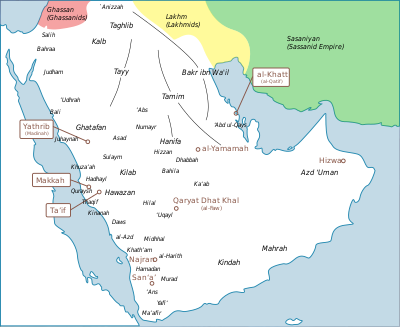Kinana
| Kināna بَنُو كِنَاَنَة | |
|---|---|
| (5th century-present) Palestine (7th–12th centuries) | |
| Descended from | Kinana ibn Khuzayma ibn Mudrikah ibn Ilyas ibn Mudar |
| Branches | |
| Religion | Islam |
Kinana (
Location
The traditional tribal territory of the Kinana extended from the part of the
History
Origins and branches

In the Arab genealogical tradition, the eponymous ancestor of the tribe was Kinana ibn Khuzayma ibn
There were six principle branches of the tribe, namely the Nadr, Malik, Milkan, Amir, Amr and Abd Manat groups. The Nadr were the parent tribe of the Quraysh, the tribe of the Islamic prophet Muhammad which were counted independently of the Kinana. The Abd Manat included the particularly strong subgroup of Bakr ibn Abd Manat, whose main branches were the Mudlij, Du'il, Layth and Damra. The Ghifar subgroup belonged to the Damra or directly stemmed from Abd Manat. Another branch, the Harith ibn Abd Manat, formed the core of the Ahabish group, a collection of small, most likely unrelated, clans.[1]
The ancestor of the Quraysh,
Early Islamic period
Islamic historians did not note the actions of the Kinana as a united tribe in the time of Muhammad, though several of the tribe's offshoots, including the Quraysh, played pivotal roles in the formation and spread of Islam.[2] The Quraysh initially opposed Muhammad and his monotheistic message, but due to previous tensions with the Bakr, were hesitant to move against him and his followers at Badr in 624 without guarantees of safety by the Kinana. The Mudlij group promised not to attack the Quraysh from the rear and they thus moved against Muhammad, who defeated them in that engagement. Later, an attack by the Bakr on Muhammad's allies, the Khuza'a, prompted Muhammad to launch his conquest of Mecca in 630. In this he received the backing of the Ghifar, Layth and Damra.[1]
Following the conquest of Mecca, there is scant information about the Kinana. An important tribesman of the Du'il,
A troop of the Kinana around me
In Palestine, swiftly mounting their steeds.[7]
The Kinana were recorded to have maintained a presence, though weakened, around Mecca in 844/45.[1]
Middle Islamic period
The
Under the
In June 1249 the naval forces of
References
- ^ a b c d e f g Watt 1986, p. 116.
- ^ ISBN 9789004097902.
- ISBN 0195778286.
- ^ a b Peters, Francis E. Muhammad and the Origins of Islam. pp. 5–15.
- ^ Crone 1980, p. 225, note 210.
- ^ Gil 1997, p. 116.
- ^ Jayyusi 2010, pp. 98–99.
- ^ Gibb 1923, p. 76.
- ^ a b Gibb 1923, p. 86, note 25.
- ^ Lane-Poole 2013, p. 238.
- ^ Runciman 1951, p. 221.
- ^ Lane-Poole 2013, pp. 232–233.
Bibliography
- ISBN 0-521-52940-9.
- ISBN 0-521-59984-9.
- OCLC 499987512.
- ISBN 978-0-231-14922-8.
- Lane-Poole, Stanley (16 October 2013). A History of Egypt: In the Middle Ages. Routledge. ISBN 978-1-134-53734-1.
- Runciman, Steven (1951). The History of the Crusades Volume I: The First Crusade and the Foundation of the Kingdom of Jerusalem. Cambridge University Press.
- ISBN 978-90-04-07819-2.
